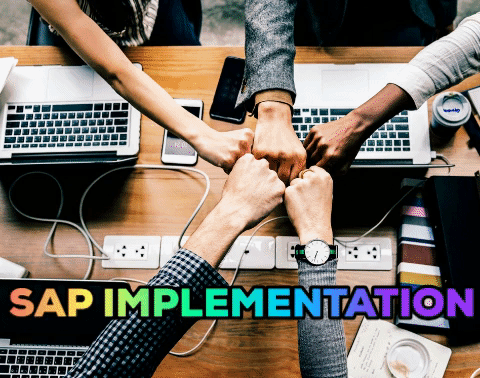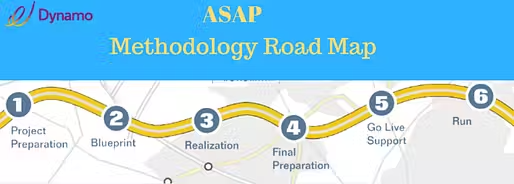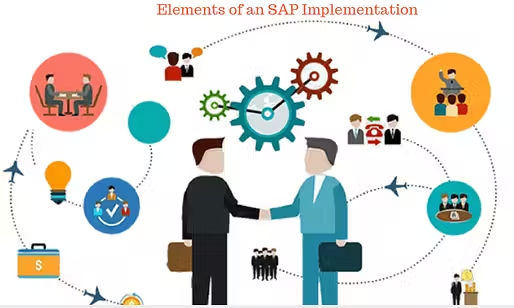An SAP implementation services is very important for the business complexity and gives good results to the organization’s resources. SAP’s functionality can gives extraordinary organizational challenges that need to be identified and managed during the preparation of design, implementation and integration of SAP software.

Using our team and technology we designed our strategic plan for the ERP Implementation methodology and toolset, Dynamo gives a successful plan, with design and implementation of software product.
What Is ASAP Methodology?
ASAP( Accelerated SAP).Its one of most significant software development life cycles process mainly used for the SAP implementation services . These methodology mainly consists of ERP System, and ASAP process with support of SAP Implementation happens.

SAP is one of best services, It Provides good security for a business and organization, SAP projects are expensive and intensive which gives you the good results to the company.They need put a lot of efforts on the work for the implementation and should have a lot of resources from the developers and managers.SAP is secure methodology to design the project its gives very good results for a business organizations.
ASAP Methodology supprates the project into the different phases. Each phase itself contains a best milestone. Mainly the project management team especially works on the current phase and start preparing for the next phase. This also offers a good roadmap and work distribution. SAP projects for implementation and Improvements as well as for the customization needed for production support and sap integration services.
What are the Elements of an SAP Implementation
SAP implementation with a project planning:
SAP implementation services have the best project plan it mainly deals with the core of the materials My goal is to bridge the gap between making the decision to purchase a my SAP software solution, and actually pulling the lever for “Go-Live,” which, in essence, makes the new system available to your end users on the Production system.
- SAP implementation project management with program support
- Business process redesign structure
- industry pre-configurations and client business requirements with gap analysis
- Organizational change management and employee communications
- SAP support training for end-users
- Data migration strategy with integration and mapping
- Technical infrastructure upgrades
- Business process and systems integration
- SAP modules, including FICO, SD, MM, PP, CRM and others
- System design and business blueprint

Dynamo provides very good ERP Implementation tools and expertise with better client support implement their SAP software faster and at a fixed cost which satisfies the client requirements. Future,Dynamo has the industry reach to effectively and best staff to your SAP project with SAP-certified functional experts.
What are the Phases of ASAP Methodology
The ASAP methodology describes a correct rout way for SAP implementation projects. It deals with a six steps process, the 6 major phases of SAP implementation:
-
- Presales
-
- Preparation
-
- Business Blueprint
-
- Realization
-
- Going Live
- Post-Production
Let’s discuss about the following steps
-
- Presale of ERP. In this presale it explains about the ERP (SAP) try to get the project from the client. basically clients consider more than one option for their business and then give all options a try to see which one provides the best result. In most cases, clients get the ERP software license directly from the software companies. This step may or may not include a test to check which ERP system is most suitable for the client.
- Presale of ERP. In this presale it explains about the ERP (SAP) try to get the project from the client. basically clients consider more than one option for their business and then give all options a try to see which one provides the best result. In most cases, clients get the ERP software license directly from the software companies. This step may or may not include a test to check which ERP system is most suitable for the client.
-
- Preparation. Once a client decided has decided on its ERP system, then they prepare the landscape of the project. In this step, server information, project cost, resources, Subject Matter Experts (SME), and business teams are decided by the PMO (the Project Management Organization). It consists of project managers, a steering committee, core business members, and sponsors. A project team studies legacy systems and gathers information regarding core systems, interfaces, what interfaces the client wants, what is necessary, what is nice to have, etc. The core team carries out “as-is” studying, a study of the current system and its processes. The project management team also hires resources and carries out project planning and outline and SAP and Support Maintenance partners.
- Preparation. Once a client decided has decided on its ERP system, then they prepare the landscape of the project. In this step, server information, project cost, resources, Subject Matter Experts (SME), and business teams are decided by the PMO (the Project Management Organization). It consists of project managers, a steering committee, core business members, and sponsors. A project team studies legacy systems and gathers information regarding core systems, interfaces, what interfaces the client wants, what is necessary, what is nice to have, etc. The core team carries out “as-is” studying, a study of the current system and its processes. The project management team also hires resources and carries out project planning and outline and SAP and Support Maintenance partners.
-
- Business Blueprint. In this phase the core team does “GAP analysis,” an analysis of the differences between the system as is and the system to be studied. providing the resources write down the terms and conditions for the new system. Integration points, interfaces and process maps are finalized. Functional consultants write the functional specification. If needed technical specifications are written down for developers to do further configuration. A testing team also started working on preparing testing steps and scenarios. Financial specifications and technical specifications are created in this step for further development and configurations.
- Business Blueprint. In this phase the core team does “GAP analysis,” an analysis of the differences between the system as is and the system to be studied. providing the resources write down the terms and conditions for the new system. Integration points, interfaces and process maps are finalized. Functional consultants write the functional specification. If needed technical specifications are written down for developers to do further configuration. A testing team also started working on preparing testing steps and scenarios. Financial specifications and technical specifications are created in this step for further development and configurations.
-
- Realization. In the realization step, functional consultants carry out configuration. Development is done for the required customization. Testing is carried out by the core team. Basis configuration is carried out by the security team. A basis team moves all configurations from one server to another for testing purpose. Testing is mostly done in the quality control server. All the configurations upload master data across all modules (sample load of few parts or entire data end as per client wants). The testing team used to test about Unit testing and integration. Unit testing, integration testing, and day-in-the-life testing happen at this stage.
- Realization. In the realization step, functional consultants carry out configuration. Development is done for the required customization. Testing is carried out by the core team. Basis configuration is carried out by the security team. A basis team moves all configurations from one server to another for testing purpose. Testing is mostly done in the quality control server. All the configurations upload master data across all modules (sample load of few parts or entire data end as per client wants). The testing team used to test about Unit testing and integration. Unit testing, integration testing, and day-in-the-life testing happen at this stage.
-
- Pre Goes Live Phase Here we see about the all configurations from the golden client will be moved to other services. Uploading master data into the new system is done mostly using LSMW, BAPI or BADI. Cut-over activities are done only when we stop the legacy system and start using the SAP system. End-user training and user documentation are carried out in this pre-go-live stage. After all cutover activities, SAP implementation goes live in a production environment.
- Pre Goes Live Phase Here we see about the all configurations from the golden client will be moved to other services. Uploading master data into the new system is done mostly using LSMW, BAPI or BADI. Cut-over activities are done only when we stop the legacy system and start using the SAP system. End-user training and user documentation are carried out in this pre-go-live stage. After all cutover activities, SAP implementation goes live in a production environment.
- Post-Production Support. In this step, the team helps the client to solve if any production issue came regarding configuration, master data change, or transaction issues.

